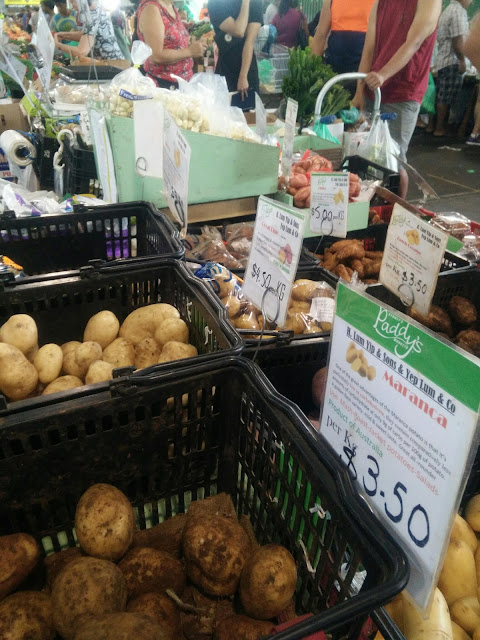My wife and I moved to Lidcombe, NSW in mid-2015. We are both vegans and interested in getting the best fresh fruit and vegetables that we can at a reasonable price - something that is at best hit and miss in the Colesworth duopoly. Luckily for us the answer proved to be just next door in Flemington, at the enormous Sydney Markets complex - the largest market complex in Australia and among the largest in the world.
Sydney Markets was established at the Flemington site, only about 25 minutes from Sydney centre by train, in 1975. Its roots however started back in 1838 when Governer Bourke allowed for land to be set aside for a large market space near George Street that eventually became Paddy's Market. Paddy's Market eventually split - its flea market and some food stalls centred in Haymarket near Central Station and becoming a big Sydney tourist attraction, its fruit and veg market moved to an enormous market space in Flemington as part of the Sydney Markets complex.
Why include the Fruit and Veg market in a list of Sydney alternative attractions? Quite simply because it is amazing - as a treasure trove of great and cheap food, for its atmosphere almost akin to a busy Middle Eastern bazaar and as a symbol of modern multicultural Sydney.
To enter the market by train one would get off at Flemington and cross a long skybridge, on weekends jostling and weaving between crowds of shoppers with wheely trolleys. The path continues along a multistory car park and down a narrow winding staircase. There is a large flea market (akin to a British car boot sale) with all sorts of cheap items, however not particularly interesting in itself.
Paddy's Flemington Market is situated at a huge green hanger with stalls inside and out. The place is vibrant with people and activity, whether it be the loud chatter and shouting of prices, the busy movement of forklifts and trolleys moving fruits and veg about or the shuffling of crowds of shoppers. There are so many stalls with every type of fruit and veggie possible (and a few meat and seafood stalls) that it is possible to feel overwhelmed, however at the same time it feels somewhat exhilarating - a feeling more akin to a Middle Eastern souk or North African medina.
Unlike the above, negotiating is discouraged and prices are clearly marked. The standout is the size and quantity of the produce - enormous bananas and zucchinis that you would struggle to see in Northern European supermarkets, huge and yummy kale and lettuce, trays of ripe strawberrys, kumquat, huge and juicy tomatoes... anything one could want. The prices also standout - usually cheaper than in supermarkets. Some great deals later on too as farmers and vendors get rid of tgeir stock. I know someone whp came later in the day and was amazed to be able to purchase a big box of mangoes all for $5!
The place is also known as a centre of Australian multiculturalism. Vendors and farmers hail from all sorts of ethnicities - Lebanese, Chinese, Italian, Korean etc. With the market situated between Lidcombe/Auburn and Strathfield there are peole from all sorts of Chinese, Korean, Southeast Asian and Middle Eastern backgrounds among the shoppers - with a small but growing smattering of inner city hipster types attracted to the high quality, cheap food and ambiance.
I will let the images speak for themselves, however there is much to be said about Paddy's Flemington Market. If you live or are staying in the inner or outer Western suburbs of Sydney, it is definitely worth a visit. Who knows, with the ambiance and the value, quality and beauty of produce on display, you might keep coming back!










































